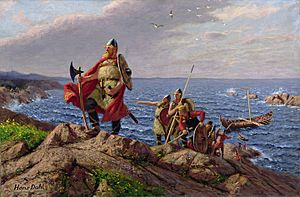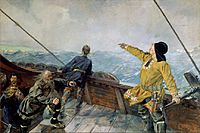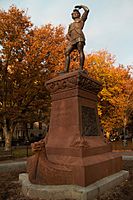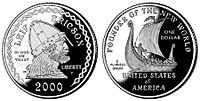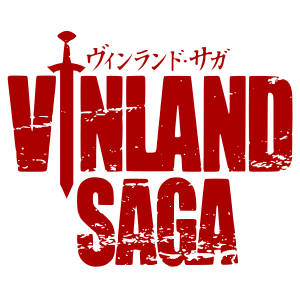Leif Erikson facts for kids
Quick facts for kids
Leif Erikson
|
|
|---|---|
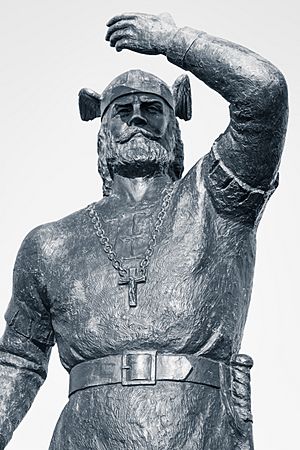
Statue of Leif Erikson in Leif Erikson Park, Duluth, Minnesota
|
|
| Born | c. 970 Icelandic Commonwealth
|
| Died | c. 1019 to 1025 |
| Nationality | Norse: Icelandic |
| Occupation | Explorer |
| Known for | First European in Vinland (part of North America; probably Newfoundland) |
| Partner(s) | Thorgunna (c. 999) |
| Children | Thorgils, Thorkell |
| Parent(s) | Erik the Red (father) Þjóðhildur (mother) |
| Relatives | Thorvald, Thorstein, and Freydís (siblings) |
Leif Erikson (born around 970 CE, died between 1019 and 1025 CE) was a famous Norse explorer. He is believed to be the first European to land in North America. This happened about 500 years before Christopher Columbus sailed there.
According to old stories called sagas, Leif started a Norse settlement in a place he called Vinland. This place is thought to be on the coast of North America. Many historians believe this settlement was at L'Anse-aux-Meadows in Newfoundland, Canada. Scientists have found Norse ruins there that are about 1,000 years old.
Leif was the son of Erik the Red, who founded the first Norse settlement in Greenland. His mother was Thjodhild (Þjóðhildur) from Iceland. Leif was probably born in Iceland, which was a new Norse colony. He grew up in Greenland at his family's home, Brattahlíð. Leif had two known sons: Thorgils and Thorkell. Thorkell later took over as the leader of the Greenland settlement.
Contents
Early life of Leif Erikson
Leif's father was Erik the Red, and his mother was Thjodhild. His grandfather, Thorvald Ásvaldsson, was banished from Norway. He moved to Iceland with young Erik. Later, Erik was also banished from Iceland. He then sailed west and found a land he named Greenland. Erik started the first permanent settlement there in 986 CE.
Leif was likely born around 970 CE. The sagas do not say exactly where he was born. But it was probably in Iceland, where his parents met. He had two brothers, Thorsteinn and Thorvald, and a sister, Freydís. A trusted servant of Erik's, named Tyrker, helped raise Leif. Leif later called Tyrker his "foster father."
Discovering Vinland
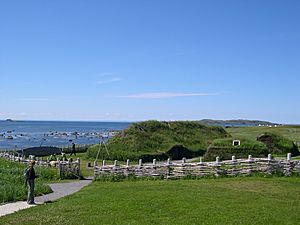
The Saga of Erik the Red and the Saga of the Greenlanders tell different stories about Leif's trips to Vinland. These sagas were written around 1200 CE. Vinland is usually thought to be the coast of North America. There are also two very old historical mentions of Vinland. They are in a book by Adam of Bremen (around 1075 CE) and in the Book of Icelanders (around 1122 CE).
Story in the Saga of Erik the Red
This saga says that Leif found Vinland by accident. He was sailing from Norway to Greenland when a storm blew his ship off course. Before this trip, Leif had been in Norway. There, he met King Olaf Tryggvesson and became a Christian.
When the storm hit, Leif was on his way to bring Christianity to Greenland. After landing on an unknown shore, his crew explored the area. They found wild grapes, wheat, and maple trees. They filled their ship with these new goods. On their way back to Greenland, they rescued some shipwrecked sailors. Because of this rescue and for bringing Christianity to Greenland, Leif was called "Leif the Lucky." Leif never went back to Vinland. But other Norse people from Greenland and Iceland did, like Thorfinn Karlsefni.
Story in the Saga of the Greenlanders
This saga tells a different story. It says Leif was not the first European to see Vinland. Instead, Bjarni Herjólfsson and his crew saw it first. They were sailing from Iceland to Greenland but got lost in fog. They missed Greenland and found an unknown coast. They did not land but kept sailing. They saw two more coasts that were not Greenland. Finally, they reached Greenland and told others about their discoveries.
About 15 years later, Leif bought Bjarni's ship. He gathered a crew of 35 men. He planned an expedition to the lands Bjarni had described. Leif's father, Erik, was supposed to join. But he fell off his horse on the way to the ship. Erik saw this as a bad sign and did not go.
Leif followed Bjarni's route in reverse. First, he landed in a rocky, empty place. He named it Helluland (Flat-Rock Land). This might be Baffin Island. He then sailed further and landed in a forest. He named this place Markland (Forest Land), possibly near Cape Porcupine, Labrador. After two more days at sea, he landed on an island. Then he returned to the mainland, sailing past a cape.
They sailed west from the cape and landed in a green area. It had a mild climate and lots of salmon. As winter came, Leif decided to stay there. He sent out groups to explore. During one trip, Tyrker found that the land had many vines and grapes. So Leif named the land Vinland, meaning 'Wineland'. There, Leif and his crew built a small settlement. Later visitors from Greenland called it Leifsbudir (Leif's Booths).
After spending the winter in Vinland, Leif sailed back to Greenland in the spring. He brought grapes and timber. On the way back, he rescued an Icelandic sailor and his crew. This earned him the nickname "Leif the Lucky." Leif never returned to Vinland, but others from Greenland and Iceland did.
Evidence of Vinland
In the early 1960s, explorer Helge Ingstad and archaeologist Anne Stine Ingstad found a Norse site. It was at the northern tip of Newfoundland. This site, called L'Anse-aux-Meadows, might be Leifsbudir. The Ingstads showed that Norse people reached America about 500 years before Christopher Columbus.
Later discoveries suggest Vinland might have been a larger area around the Gulf of St. Lawrence. The L'Anse aux Meadows site may have been a place to repair ships. It could also have been a stop for trips to other parts of Vinland. This does not go against L'Anse aux Meadows being Leifsbudir. The sagas seem to describe Vinland as a larger region with several settlements.
Leif's personal life
Leif was described as a smart, thoughtful, and strong man. He was also very good-looking. When he was old enough, Leif went to Norway. He likely served King Olaf Tryggvason. On this journey, Leif's ship was blown to the Hebrides islands. He and his crew had to stay there for most of the summer.
During his stay, Leif fell in love with a noblewoman named Thorgunna. She gave birth to their son, Thorgils. Thorgunna stayed in the Hebrides when Leif left. He did not take her with him because he needed her family's permission. Thorgils was later sent to Leif in Greenland. But he was not very popular there.
After reaching King Olaf Tryggvason's court in Norway, Leif became a Christian. Both the Saga of Erik the Red and Olaf Tryggvason's Saga say that King Olaf asked Leif to return to Greenland. His mission was to convert the settlers there to Christianity. During this trip, he was blown off course and discovered Vinland. Then he found his way back to Greenland.
Leif's father, Erik, did not want to change his religion. But his mother, Thjóðhildr, became a Christian. She built a church called Thjóðhild's Church. Another version of Olaf Tryggvason's Saga says that Leif did not get blown off course. It says that after he arrived in Greenland, everyone there became Christian, including his father Erik. Some stories also say Leif brought a priest and other church leaders to Greenland. If true, Leif and his group would be the first Christian missionaries in the Americas. This was before Christopher Columbus's voyages.
The winter after Leif returned from Vinland, his father died. Leif then became the main leader in Greenland. Leif is last mentioned alive in 1019 CE. By 1025 CE, his leadership had passed to his other son, Thorkell. The sagas do not say how Leif died. He probably died in Greenland between these dates. We do not know much more about his family after Thorkell became leader.
Is the story true?
Leif Erikson was very likely a real person. He is probably the first known European to land in North America. However, some parts of his story are debated. Some experts think that Leif's sister, Freydís, and his foster father, Tyrker, might be made-up characters. Their roles in the Vinland sagas might not be true. Also, Leif being sent as a missionary to Greenland might be fictional. This part of his story often comes from a specific version of Óláfs saga Tryggvasonar.
Leif Erikson's legacy

Leif's successful trip to Vinland encouraged other Norse people to travel there. The Norse were the first Europeans to try to settle in North America. However, they did not create any permanent settlements. But they might have made trips to Markland for wood and trade for many years.
The way these trips are mentioned in old texts suggests they were not seen as hugely important at the time. Or maybe everyone already knew about them. Knowledge of the Vinland journeys spread across medieval Europe. A writer named Adam of Bremen even mentioned Vinland around 1075 CE. He heard about it from the Danes. Some people think that knowledge of Vinland might have been known in European seaports in the 1400s. Christopher Columbus said he visited Iceland in 1477. He might have heard stories about Vinland there.
Norse meetings with Indigenous peoples
Leif Erikson himself did not meet the native people of Vinland. But later Norse explorers did. They called them skrælingi, which was an old term for "wretches."
The Saga of Erik the Red says the first meeting happened during a trip led by Thorfinn Karlsefni. Leif's brother Thorvald was also on this trip. At first, the Norse traded with the natives. But weeks later, the new Norse settlement at Hóp was attacked. Karlsefni decided to leave that settlement. The Norse moved to another settlement called Straumfjǫrðr. They stayed there and kept exploring. One morning, they met a native person with one leg. This person shot an arrow that killed Thorvald. Thorvald famously pulled out the arrow and said, "This is a rich country we have found; there is plenty of fat around my entrails," before he died. On their way back to Greenland, Karlsefni's crew captured two native boys. They took them to Greenland.
The Saga of the Greenlanders says Leif's brother Thorvald was the first to meet the natives. This happened while Thorvald and his crew were exploring the coast, probably in the Markland area. They found nine natives sleeping under boats. They attacked them, killing eight, but one escaped. In a later fight, Thorvald was killed by a native's arrow. Later, Thorfinn Karlsefni led a group to settle Vinland. They met natives and traded with them at first. But relations got bad when a native was killed trying to steal weapons. In return, the natives attacked, and Karlsefni decided to leave the colony.
Statues and celebrations
Stories of Leif's journey greatly influenced people of Nordic descent in the United States. The first statue of Erikson was put up in Boston in 1887. Another statue was put up in Milwaukee. A statue was also placed in Chicago in 1901. This was for the 1893 World's Columbian Exposition. A copy of a Viking ship from Norway also arrived then. A painting called Leiv Eirikson Discovering America by Christian Krohg was also made for the 1893 Exposition.
In 1925, President Calvin Coolidge spoke at the Minnesota State Fair. He told a crowd of 100,000 people that Leif was indeed the first European to discover America. More statues of Leif were put up. One was at the Minnesota State Capitol in St. Paul in 1949. Another was near Lake Superior in Duluth, Minnesota, in 1956. And one was in downtown Seattle.
In 1930, a statue of Leif was put up in Reykjavík, Iceland. It is now in front of Hallgrímskirkja. This was a gift from the United States to Iceland. It celebrated 1,000 years of Alþingi, Iceland's parliament.
The Leif Erikson Awards started in 2015. They are given every year by the Exploration Museum in Húsavík, Iceland. These awards honor achievements in exploration and studying the history of exploration.
Several ships are named after Leif. These include a Viking ship replica, a commercial ferry, and a large dredger.
Leif Erikson Day
In 1929, the Wisconsin Legislature made October 9 "Leif Erikson Day" in their state. In 1964, the United States Congress asked the president to declare October 9 each year as "Leif Erikson Day." On October 6, 2000, President Bill Clinton officially proclaimed October 9, 2000, as Leif Erikson Day.
The sagas do not say the exact date Leif landed in America. They only say it was in the fall. October 9 was chosen because it was already a special date for Norwegians in America. On October 9, 1825, the ship Restaurationen arrived in New York Harbor. It carried the first organized group of Norwegian immigrants from Stavanger.
Gallery of art and sculptures
-
Leif Eriksson Memorial (1929–1932), Reykjavík, Iceland. This statue is at the front of the Hallgrímskirkja. There is a copy of this statue in Newport News, Virginia, USA.
-
Leif Erikson by John K. Daniels, 1948–49, near the Minnesota State Capitol.
-
The oldest public statue of Leif, placed in Boston in 1887.
Leif Erikson in fiction
- Leif is the main character in the 1928 film The Viking.
- In children's books, there is Leif the Lucky by Ingri and Edgar Parin d'Aulaire, published in 1941.
- Leif is one of the main characters in Makoto Yukimura's manga Vinland Saga.
- Leif is the main character in the historical novel Vinland the Good by Henry Treece. It is about Viking explorations.
- An Old Captivity is a novel by Nevil Shute. It includes a dream where a character named Leif Ericson appears.
- Leif is a main character in the Netflix historical drama series Vikings: Valhalla. He is played by Sam Corlett.
See also
 In Spanish: Leif Erikson para niños
In Spanish: Leif Erikson para niños


